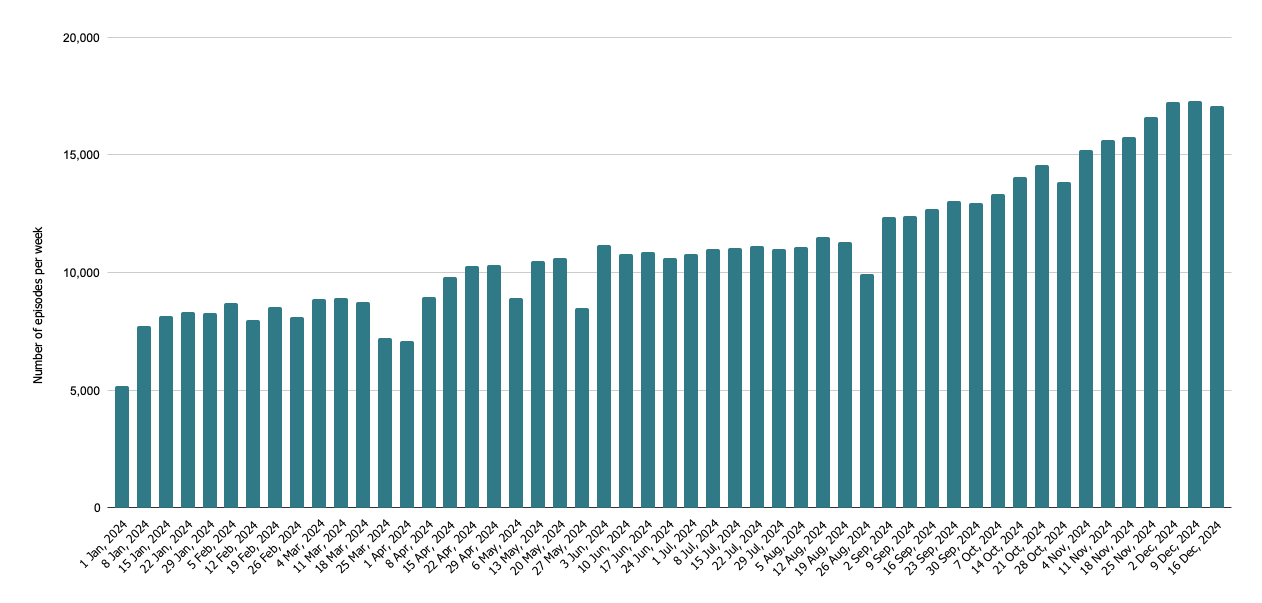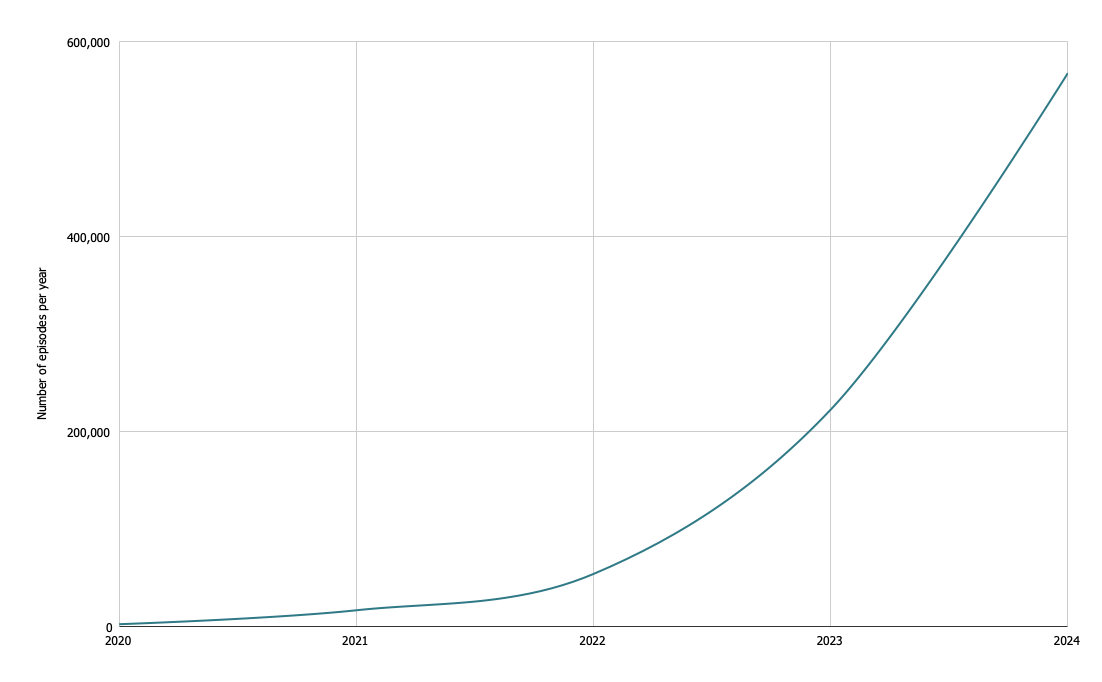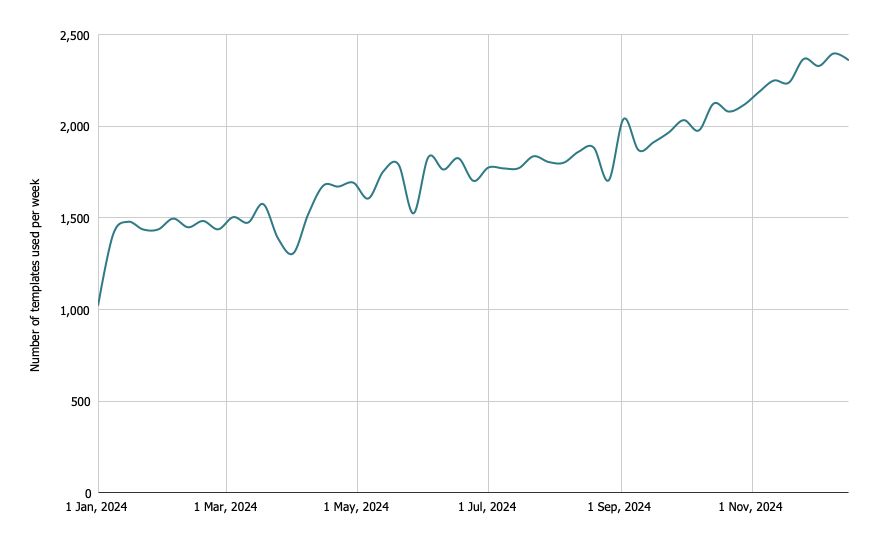Buckle in; here’s your Concentric long read for the year! 2024 was a year of 250% year-on-year growth in use, 90,000 patient feedback responses, 6,000 new clinician users, 14 product releases, and 5 new team members. A year of better understanding the health economic impact of digital consent. A year when the most requested feature of 2022 and 2023 was delivered. Let’s dive into the detail 🤓
Deployments right across the UK
Many clinicians used Concentric for the first time in 2024, around 6,000 in fact, across new and existing deployments. Here are some of our roll-out highlights:
- Go-lives across 5 NHS Trusts including Barts Health, West Hertfordshire Teaching Hospitals, Wirral University Teaching Hospital, Sandwell and West Birmingham Hospitals, and the Isle of Wight. Facilitated by ever-maturing operational processes and product maturity, we’ve seen Trusts delivering faster roll-outs, including Barts Health’s roll-out across all sites over 6 months.
- Expansion of our deployment across Circle Health Group’s (CHG) hospitals, from a handful of sites at the start of 2024 to all 54 CHG hospitals, including Scottish and Welsh sites, by the end of January 2025.
- Integration with Carebit, a leading practice management system, has seen many individuals and clinics start to use Concentric seamlessly alongside Carebit as part of their private practice. Adam Blackburn, Consultant Plastic Surgeon, said of the integration “Together, Carebit and Concentric create a streamlined, patient-centred experience that prioritises clarity, comfort, and trust in care.”
- University Hospitals Leicester became the first NHS Trust to pass 2,000 patient consents per week during their transition to a digital consent by default state across the ICS. Thanks in particular to Alex Boddy, Consultant Oesophagogastric Surgeon and clinical lead for digital consent at the Trust, for his leadership during the implementation.
What of the impact and experience?
In 2024, we started to see indications of the economic impact of digital consent, and the numbers are more conclusive than we thought they might be. Published in the health economics journal PharmacoEconomics, a study showed that when considering the whole pathway, there was a saving of approximately £0.90 per consent episode when using Concentric compared to a paper-based consent process. The findings indicated that the most significant savings were found in the elimination of paper form ordering, printing, storage, and transport costs. A link to the paper, and Connor’s summary, can be read in the evidence summary.
Ed (Co-founder and Chief Medical Officer) and Connor are working with several teams across the UK and internationally to investigate the many potential implications (positive and negative) of introducing Concentric. Want to get involved or collaborate on a new research project? Get in touch!
How did patients rate Concentric in 2024?
Ninety thousand patient users shared feedback in 2024. They gave the product and process an average rating of 4.66/5, with 71,679 patients giving Concentric the full 5-star rating – that’s pretty cool!
Beyond the numbers, patients told us:
- “I think it was very good, helpful, and gave me a better understanding of what is going to happen.”
- “It was reassuring to have a clearly laid out form with the pros and cons of the procedure.”
- “Being visually impaired, I was able to use read-aloud on my phone to read the document to me instead of relying on someone else.”
It would be remiss of us to claim that all the feedback was entirely positive, with patients giving us things to work on going into 2025:
- “I would have liked more detailed visual information…for example a drawing to explain?”
- “Struggled to change the language for my parents; this could be made more intuitive.”
In that context, we applied for and were selected for a digital consent and health inequalities programme led by University Hospitals Coventry and Warwickshire NHS Trust. Over the Autumn, we worked with the Trust, the University of Warwick, and fellow innovators such as Cardmedic to explore digital consent’s role in supporting health equality. You can dive deeper into our summary of the programme, outputs, and ongoing work, and this work feeds into our plans for product development in 2025 (more details below).
Have clinicians been giving feedback?
We review every feedback submission from clinicians, which often contain requests for new or improved features. We use the feedback to prioritise our development ‘sprints’ – the two-week blocks in which our product and technical teams structure their work – with updates making their way into our product releases. The ones where you say you love the product are nice, too!
If you’re a Concentric user, please share your experiences and tell us what’s going well or what we should work on next. You can do this within the app (click ‘Give feedback’ in the account menu), on social media (links in the footer) or via email (support@concentric.health). The more we hear from you, the better we can tailor and prioritise to meet your evolving needs. Thank you.
💙Concentric (also known as e-consent) is our go-to app for everything about digital consent to treatment, developed by our partners @concentric_hlth - it's changing the way patients and clinicians handle the consent process.
— PHU Digital (@PHUDIGITAL) March 18, 2024
Our product highlights
We release updates every month or so, constantly iterating Concentric based on product insights and feedback from users and project teams. Our technical team – Elm Engineers Adrián and Andrew and CTO/Co-Founder Martyn – delivered 14 production product releases in 2024 👏 As always, you can read our public release notes which accompany each release, but I’ve picked out a few favourites:
Custom templates: By far, this was our most requested feature in 2023, and we were delighted to bring the custom templates feature to Concentric in September, allowing clinicians the flexibility to use both their own templates and Concentric templates.
Read-only access: In January, we made it possible to create read-only users; these users are able to view but not create/edit consent episodes. We’ve seen read-only access used widely for those involved in the consent pathway but don’t have consent conversations with patients themselves, such as ward and theatre staff.
iframes: Many organisations use a ‘patient context launch’ to open a Concentric patient record from within their electronic health record (EHR). Previously, this link would open in a separate browser/tab. The addition of iframe integration means that it’s now possible to use Concentric right within the EHR, making the clinical workflow feel even more seamless.
A growing ontology
The Concentric ontology is the most comprehensive consent resource globally and is the clinical content that underpins the Concentric application. The ontology now stands at 2,577 treatment templates, up from 2,133 at this time last year.
The specialties that have seen the greatest increase in template numbers are cardiothoracics (up by 54%!) and orthopaedics, which saw an additional 131 templates added.
This increase has been helped enormously by Brogan and Bowie, our new Ontology Clinicians, who joined us in mid-2024. They’ve both hit the ground running and together manage the clinical content in Concentric. If you want to see more detail about their updates, check out the content updates release notes.
We were all sad to see Jade pause her Ontology Clinician role at Concentric to take up her fellowship in Cardiothoracic Anaesthesia at the Bristol Heart Institute, having been the second largest contributor to the ontology (behind husband Daf!) to date. I say pause; we’ll keep trying to convince you that consultant post + Concentric should be the 2026 plan! Thank you, Jade.
Exponential growth continues
While the evidence about the benefits of digital consent continues to grow, so too does Concentric usage:
The first full working week of 2024 saw 7,500 patients record their consent in Concentric; by the last, this number had more than doubled to over 17,000.

The first clinical use of Concentric was in 2020; each year since, the number of patients who have used Concentric each year has increased exponentially. This graph shows how that number has changed over the years:

That’s over 500,000 patients supported, often at big life-changing moments, during 2024. Daf’s message has always been that the team’s most important metric is the overall impact we have on patients, and that the beauty of digital health at scale is that we can all - clinicians and non-clinicians - have the same or more impact on patients as a Consultant Surgeon/Physician. Seeing that scale become a reality is such a driving force for us all.
Whilst there are 2500+ Concentric treatment templates, some are used more than others. Here’s the top eight in terms of volume of use in 2024:
| Procedure | Episodes |
|---|---|
| OGD | 35,413 |
| Colonoscopy | 35,200 |
| Cataract surgery | 21,780 |
| Flexible cystoscopy | 17,855 |
| Excision biopsy of a skin lesion | 11,787 |
| Flexible sigmoidoscopy | 11,664 |
| Planned caesarean birth | 9,857 |
| Total hip replacement | 7,138 |
Of those 2500+ templates, how many are actually used? Well, quite a lot it turns out! Including combinations, there were 2359 templates used in the final week of the year, with this number increasing across the past 12 months:

Our team: focussed on this unique challenge
We’re now a team of 12 with 5 amazing colleagues joining during the year. Adrián, Chloe, Bowie, Brogan, and Terouz – what an amazing difference you have all made to the team, the culture, and the impact we can have together.
Working mostly remotely, we had our first team away week in May, staying in the Cotswolds, and working on some exciting projects together.

The trip also saw the first edition of Concentric Dine with Me – I would be surprised if it was the last… Here’s just the intro to the 1-hour ‘directors cut’ episode that was watched on the last night!
For many deploying organisations, the face of Concentric week-to-week is now Chloe, who joined as Clinical Operations Lead in April. (Yes, that was my job! More on what I’m doing now in the next section!) I’ve learnt a lot from watching you take on the reigns; the deployment of Concentric into large organisations feels like a well-oiled machine by now.
We’d long wanted to start developing a portfolio of images to complement the Concentric written content, and it’s been a pleasure to have surgeon and illustrator Terouz (take a look at Terouz’s portfolio) join us towards the end of the year. Users can expect the first of these images to start landing in Concentric’s patient-facing views in 2025, and we can’t wait for you to see them.
International use of Concentric
With Concentric now well established in the UK as the leading digital consent product, and with the limitations of the paper consent process not being unique to the UK, we are starting to see overseas use of Concentric. In light of this, I have relocated to Australia to lead the expansion in Australasia (now one of 3 of the team based outside the UK – we’ve had to start keeping track of people’s time zones!). Christmas out here was as surreal as everyone says it is!
Closer to home, we have seen continued use of Concentric by individual surgeons in the Republic of Ireland, with plans for clinical use in a major hospital in 2025.
Wherever you are in the world, if you’re curious about starting to use Concentric, get in touch with me via our contact page.
Our priorities for 2025
We still see ourselves as being early on this journey; expect us to keep driving digital consent forward alongside our increasing number of deploying organisations and partners during 2025 and for many years to come. Inevitably there are many things we will look to tackle during the year, and we’ll remain agile to evolving needs, but here are some current priorities:
- Building on the UHCW project and Terouz’s initial portfolio of images, we expect an updated patient app and consult view, and deeper embedding of accessibility and translation functionality, to feature heavily in our product development.
- Broadening the type of consents that Concentric is well suited to, for example, genetic testing and clinical photography, and more flexibility around cross-organisational working to support the increasing use of surgical hubs.
- Increased operational focus on and optimisation of long-term BAU support now that many have transitioned to digital consent by default, for example, better tooling to support annual consent audits.
- International engagement with a dual aim of having an increasingly international impact and learning from systems internationally, putting us in a position to continue to drive standards in informed consent and shared decision making, and do so on a global scale over the coming years.
Thank you for reading, and here’s to a happy and healthy 2025!
